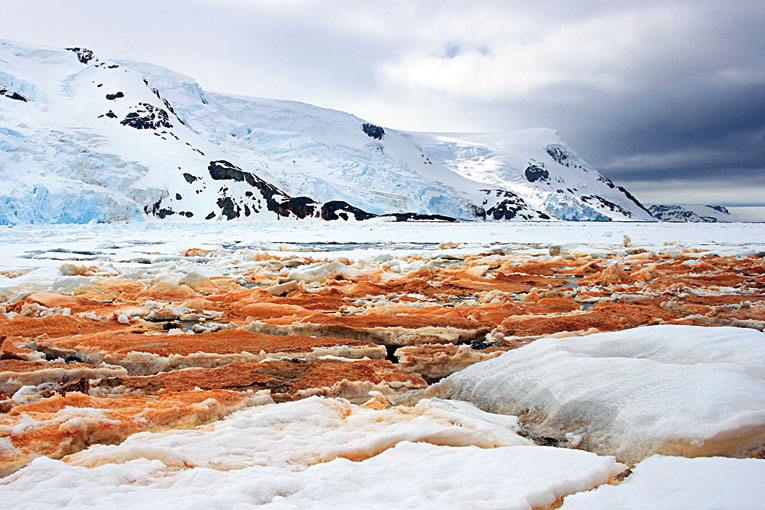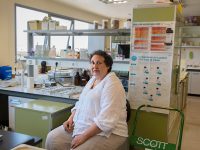Is life a cosmic imperative?
Reflections on research and expectations

|
In the early 18th century, the great astronomer Johannes Kepler had already finished what is today considered the first science-fiction novel ever written. Somnium,published in 1634, after his death, tells the story of Duracotus and his mother Fiolxhilde’s travel to the Moon. When Duracotus comes back home after having spent some time under Tycho Brahe’s instruction, Fiolxhilde suggests he should make a journey to get to know by experience what he had studied. The journey is made possible thanks to his mother’s dealings with wise spirits capable of taking her to any place of her choosing. In the end, the story is only an excuse for Kepler to explain how he imagined the Moon’s surface, how one might be able to live there, and how he thought stars looked like from the Moon. Even thought this description was poetical and imaginary, Kepler did show his great intuition regarding some aspects like the possible effects of solar radiation during the journey or the relationship between life and the environment. Unlike many others who wrote before and after him about life on the Moon, Kepler imagined both plants and animals different from the ones living on Earth, conditioned by the environment’s hostility and high temperatures during the day. A YOUNG EARTH The history of life cannot be understood without some knowledge of Earth history. One of Charles Darwin’s theory of evolution’s main points is the gradual view of change in geology put forward by Charles Lyell, which Darwin transferred and applied to biology. Evolution needs suitable raw material, but also needs a very long period of time in order to develop a complex chemistry. The history of Earth is the history of the universe itself— of how 13.700 million years ago the matter we know appeared, and how stars, planets, complex chemical compounds, molecules, metabolisms and organisms have come to being throughout astronomical time. We have strong evidence to say that these processes have happened in our Solar System as well as in the rest of the universe, so we can start by studying what is closer to us and then we can try to apply this knowledge to other planetary systems. Five thousand million years ago the Earth was a burning and shapeless mass of melted rocks, gas, dust and small part of the matter that was forming our Solar System. Around 500 million years later, it had an intense volcanic activity and its surface was constantly hit by fragments of matter. The Earth resisted chemical organisation for 500 million years, we believe. Likewise, we are still discussing today at what exact moment did the first cells fossilised in ancient rocks. We know that it was at least 3.500 million years ago, or maybe 3.800. The conclusion drawn from this is that once the temperature on the Earth’s surface dropped enough to enable some complex molecules to remain stable and liquid water became a common element, life emerged and rapidly colonised the planet. Apparently, inert matter became living matter in a few hundred million years, in a way that we have not yet discovered or imagined. It is possible that the Earth is not the only place in the universe were this process has occurred. The first cells to ever appear were the ones we call prokaryotes— they lack a cell nucleus and are today classified as Bacteria or Archaea. Almost certainly life started within liquid water, maybe in a coastal area or in shallow waters, or maybe in a warm area in the depths of the ocean. There are some indicators that support the thermophile or hyperthermophile origin of life, which means that the first cells started their development in hot or very hot environments. Even though there is no agreement on this possibility, there have been found some fossils of hyperthermophile organisms 3.200 million years old, which in any case supports an early appearance. Nowadays there is research on many ecosystems and the different chemical reactions that can happen in oceanic depths, a region where we have found many organisms adapted to high temperatures. |
 © Mètode «The discovery of extremophiles have forced us to rethink which are the environmental requirements for life to happen» |
|
 © NASA/JPL-Caltech Curiosity. On the lastl 6th of August 2012, Curiosity landed on crater Gale, 5° 24’ S 137° 48’ E.It is the biggest vehicle ever sent to outer space —it weighs around 400kg and is more than two metres tall. Among its tools we can find REMS (Rover Environmental Monitoring Station), developed by the Astrobiolgy Centre (INTA-CSIC). Check NASA’s website <mars.jpl.nasa.gov/msl/> to follow the mission’s updates. |
«Mars is a planet that has fascinated human beings even before we had the first telescopes that enabled us to identify it as a planet with the surface variation earlier recognised in the Earth and in the Moon» |
|
|
EXTREME LIFE In the later decades of the 20th century, we have been witness to the discovery and characterisation of special forms of life— extremophile organisms. Most of them belong to the genus Archaea, although we know many eubacteria and even some animals able to live in what would be extreme conditions for us humans. Some extremophiles resist high pressures from oceanic depths, the constant cold in ice deserts or draughts in the driest areas on Earth. These discoveries have forced us to rethink which are the environmental requirements for life to happen. In fact, liquid water, nutrients and a source of energy are just enough. Psychrophile organisms grow in frozen small dust particles, around which there is a small quantity of liquid water. Some hyperthermophiles live nearby deep-sea vents, where temperatures are well over 100˚C. Life survives within a range of -20˚C-120˚C, and we believe now that this range is not final. On the surface, thermophiles colour thermal water areas, where sulphur compounds work as a source of energy for boiling mud. The most renowned example of this spectacular phenomenon can be found at Yellowstone National Park—the Grand Prismatic Spring. Halophile microorganisms need high levels of salt in water and resist desiccation. They are responsible for the pinkish hue we can see in many salt lakes. Other microorganisms have adapted to radiation levels 100 times higher than the ones human beings can resist In the end life springs in acid environments, similar to rivers of vinegar, and alkaline lakes, similar to soap diluted in water. There is life even inside rocks— there is a deep and warm biosphere, with a higher biomass than the biomass in all plants and animals living on the Earth’s surface. Subsoil environments should be main targets when exploring other worlds, since it effectively protects against radiation. Radiation, lower gravity levels and low temperatures are the most common situations found in other planets; but the life known to us can resist wide variations in all of them. MARS, OUR TWIN PLANET Mars is a planet that has fascinated human beings even before we had the first telescopes that enabled us to identify it as a planet with the surface variation earlier recognised in the Earth and in the Moon. Mars is very similar to Earth in some respects, but it has never ceased to surprise us. Martian topography suggests that thousands of millions of years ago, when it had a denser atmosphere and a warmer climate, the planet may have been partially covered by a great ocean in its Northern hemisphere. Nowadays Mars has a light atmosphere, mainly made up of carbon dioxide. Its morphology is a spectacular one— with half the Earth’s radius and a third of its surface, we find there the highest mountain (Olympus Mons, 21km high) as well as the deepest and largest deep (Valles Marineris) in the Solar System. Seasonal changes darken each of Mars hemispheres for half a Martian year or a terrestrial year, approximately. When the sunlight does not reach the planet’s surface, this is usually covered by CO2 ice, which means that temperatures are under -128˚C. When Spring comes to each of the hemispheres, temperatures increase, carbon dioxide becomes gas and a great deal of permafrost remains partially exposed in the surface. Studies on Mars’ climate show that during warm periods temperatures are sometimes over 0˚C. Recent measurements carried out by the THEMIS (Thermal Emission Imaging System)— in Mars Odyssey spaceship— showed that, even in high latitudes, temperatures are high enough so as to have liquid water for some weeks every year. Under these circumstances it would not be impossible for some terrestrial organisms to survive in these micro-climates, combining developmental and reproductive periods with lethargic and inactive periods. In the last fifty years we have sent more than forty missions to the red planet and have attempted around fifteen landings. The last mission sent left our planet in November 2011, and at this very moment the Curiosity is rolling over Mars’ surface, where landed on the last 6th of August. This mission will report about the Martian climate, its geology and its habitability, and will set targets for future missions. Maybe in the following decade we will be able to send a new mission that returns to the Earth bringing some samples, a prerequisite to consider manned missions, although these do not seem feasible until the second half of the 21st century. We will have to be content with fiction. |
||
 © NASA’s Solar Dynamics Observatory spacecraft. Muntatge: S. C. Manrubia Extrasolar planet detection method. When a planet passes across the star it is orbiting, the quantity of light emitted by the star decreases. When this change can be detected accurtely enough and happens on a regular basis, we have strong evidence of having found a planet. This is how we get data of the planet’s radium or its orbital period. This picture shows the transit of Venus on the 5th of June, 2012. |
«From all identified planets, thirty of them have been directly photographed and it is thought that only four of them are potentially habitable» |
|
|
GEL JOVIAN SATELLITES As we get farther from our planet, it gets increasingly difficult to obtain complete information about the bodies in our Solar System. A very interesting group that is currently catching everyone’s attention and efforts is the one made up of Jupiter’s gel satellites. Europa. Io, Ganymede and Callisto were discovered by Galileo Galilei in 1610 thanks to a new telescope. They are the four largest moons in the Solar System. Io, the closest to Jupiter, is affected by so violent tidal forces that they deform the satellite’s surface and keep it in nonstop volcanic activity. Callisto, the farthest satellite, is also one of the less affected by the warming tidal forces. It has a solid nucleus and, probably, a small ocean under a complex surface that has many craters. Europa is completely covered by water ice. Its surface is constantly renewing itself, and under this there is an active ocean that covers the whole satellite. We cannot discard that Europa is a world full of life. The great reddish crevices that cross its surface apparently point to the presence of carbon compounds that come from within the satellite. The four Galilean satellites set many questions and set the expectation of finding a wide range of new geological and chemical processes —who knows if even biological ones— as we have with Mars’ exploration. A few months ago, the JUICE (JUpiter ICy moons Explorer), mission was approved, which is expected to be ready to get to the Jovian system in 2022. It will get there after a seven year long journey and, from 2030, it will send back unprecedented quality data about Jupiter’s atmosphere and the habitability conditions of its satellites, especially Callisto and Europa. EXTRASOLAR PLANETS Giordano Bruno sensed that stars had to be similar to the Sun and therefore, according to Copernicus’ heliocentric model —by then a recent one— , must have Earth-like planets orbiting it. This view was confirmed some four hundred years after Bruno was burnt at the stake (1600), when the first extrasolar planet was discovered orbiting around some other star. It was 1995 and it was named 51 Pegasi b. This planet orbits around a star called 51 Pegasi in four terrestrial days, its temperature is well over 1000˚C and its mass is similar to half of Jupiter’s mass. Ever since this first discovery, there have been found another 777 extrasolar planets (July 15, 2012). Most of them are Jupiter-like, easily detectable due to their big mass, and for now we only have a few examples of Earth-like planets. Statistics could be reversed thanks to new technological developments and missions especially devoted to the search of Earth-like planets, like the Kepler telescope. From all identified planets, thirty of them have been directly photographed (we know the rest of them for their effects) and it is thought that only four of them are potentially habitable. In spite of the hopes risen by science fiction and a poor knowledge of the actual difficulties of interstellar travels, it is impossible to do them with the current technology available. We have to take into account that it takes more than seven years to get to Jupiter, a journey that light makes in no more than two or three hours. 51 Pegasi B is 50.9 light years away from us. |
||
|
A THRILLING JOURNEY Fascination for other worlds is certainly very old, but it has been only in the last 50 years that have we started to actually grasp how reality is in some of these worlds. For now, our knowledge on extrasolar planets is still very scarce to talk about their habitability. We have Mars’ and Europa’s examples— two near worlds where some terrestrial extremophiles might survive even without the need of adapting. Life is strong, plastic and unstoppable— the survival of only one species means the generation of new ones that, no doubt, are capable of colonising neighbouring environments. It only takes time. Limits to adaptation are only in our imagination. We have very little certainties, many questions and a lot of incomplete answers— we still have a very thrilling journey ahead of us. Bibliografia complementària Susanna C. Manrubia. Head of the Evolutionary Systems group at the Centre for Astrobiology (INTA-CSIC). Madrid. |
||
Bibliografia complementària
Davies, P., 2006. El quinto milagro. En busca de los orígenes de la vida. Crítica. Barcelona.Giménez-Cañete, Á. et al., (coord.), 2011. Astrobiología. Sobre el origen y evolución de la Vida en el Universo. CSIC. Madrid.Gross, M., 2001. Life on the Edge: Amazing Creatures Thriving in Extreme Environments. Plenum Press. Nova York.Luque, B. i Á. Márquez, 2004. Marte y vida: ciencia y ficción. Equipo Sirius. Madrid.Neal Irwin, L. i D. Schulze-Makuch, 2010. Cosmic Biology: How Life Could Evolve on Other Worlds. Springer. Nova York, Dordrecht, Heidelberg, Londres.Yagoob, T., 2011. Exoplanets and Alien Solar Systems. New Earth Labs. Baltimore.





